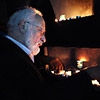The Revival Of The Spiritual Level
 The Torah, “Numbers” 20:27 – 20:29: Moses did as the Lord commanded him. They ascended Mount Hor in the presence of the entire congregation. Moses then stripped Aaron of his garments and dressed Eleazar his son in them, and Aaron died there on the top of the mountain. [Then] Moses and Eleazar descended from the mountain.
The Torah, “Numbers” 20:27 – 20:29: Moses did as the Lord commanded him. They ascended Mount Hor in the presence of the entire congregation. Moses then stripped Aaron of his garments and dressed Eleazar his son in them, and Aaron died there on the top of the mountain. [Then] Moses and Eleazar descended from the mountain.
The whole congregation saw that Aaron had expired, and the entire house of Israel wept for Aaron for thirty days.
Death spoken about in the Torah—the deaths of Aaron, Miriam, Moses, or other souls that attain the Creator and which are the foundations of the general system of man’s soul—means an ascent, not the demise of the body. The body is the corporeal level of a person and so there is nothing to mourn.
In the spiritual world, if the system called Aaron has completed its role, Aaron dies because he need not correct himself anymore; it is completely corrected to join the common system of the soul of Adam. This is called death.
What we regard in our world as a tragic event is a great joy in the spiritual world. It is written that the “…righteous, who, in their death, are called living.”
Question: But it says here that “the entire house if Israel wept for Aaron for thirty days.”
Answer: They wept because he was no longer with them, but was incorporated in the general state, so they couldn’t count on him specifically.They are deprived of the visible, physical support and communication, but of course, the whole system called Aaron remains. It is an enormous sub-system of the leadership in the general soul of man, but not the same level that the people are on. This is the reason they wept for him, but for a very limited time.
We mourn the dead for seven days, then in the memorial service after thirty days, and then once a year, not more than that. There are special days of visiting the cemetery: seven days after the burial and then after thirty days, and then once a year on the day that the person passed away. The reason is that death is the revival of the spiritual level that is totally detached from the body that is buried. Baal HaSulam used to say that he didn’t care at all where his sack of bones would be buried.
In ancient times, 2,500 to 3,000 years ago, before the exile from the land of Israel, the deceased were placed in a cave and walled in for one year. In a year, the caves were opened and everything that was left of the decayed bodies was collected in a vessel, sealed, and placed in a common cave. The tradition to bury dead bodies in the ground appeared later.
Today, we know the places of many ancient burials in various regions such as Syria, Iraq, Iran, and so on, since the land of Israel was much broader at that time than today. For example, Moshe and Aaron are buried on the other side of the river Jordan.
Many of the graves of ancient Kabbalists who lived more than 2,000 years ago, before the destruction of the Temple, are located in Galilee. The ARI, the greatest Kabbalist of the 16th century, listed them. That’s how they were discovered.
The ARI walked the fields between Safed and Mount Meron where Rabbi Shimon was buried and pointed out the sages’ graves. Then, the tombstones with the names of the Kabbalists were placed on the graves.
The ARI sensed who and where each was buried because the root and the branch are linked. Even though the body is not a spiritual part of the human being, it still is related somehow with the spiritual component and suffers together with it. So the ARI was able to accurately find the connection and locate the burial places. Since then, monuments to great Kabbalists can be seen in Galilee.
[171038]
From KabTV’s “Secrets of the Eternal Book” 7/1/15
Related Material:
Moses And Aaron, Faith And Knowledge
The Nation’s Servants
Forefather Of All Cohens In The World







Discussion | Share Feedback | Ask a question